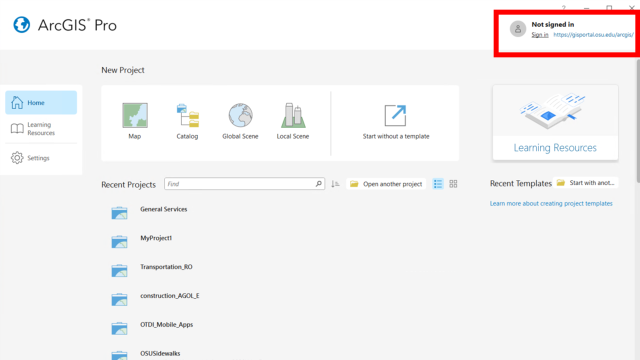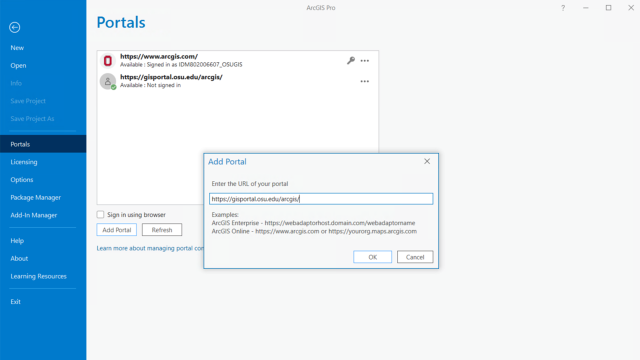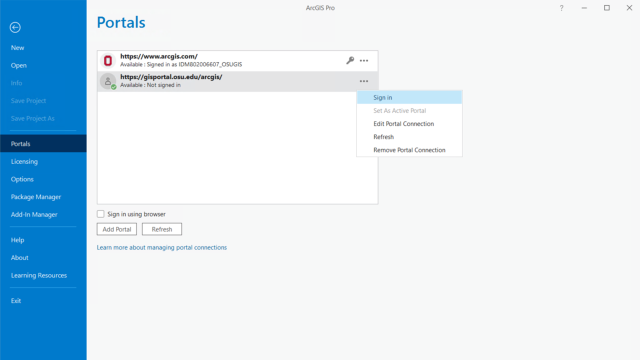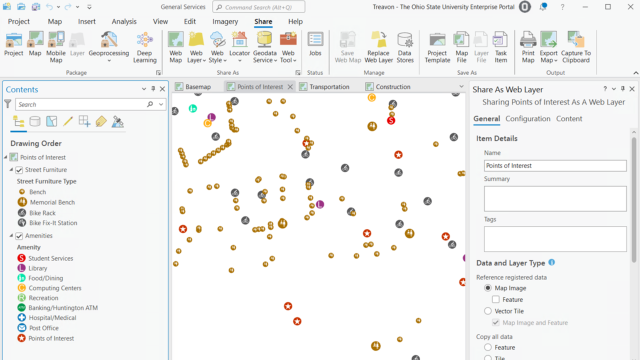Overview:
This article is a step by step guide to creating GIS Services.
A service has many different configurations and the details can be found in ESRI Documentation. Imagery Services have specific documentation that is more precise.
Step 1, Set Up:
Ensure you have signed into an ArcGIS Portal account and have permission to publish content. Many users sign in and use ArcGIS Pro through an ArcGIS Online Account. This will not let you publish services to the FITS ArcGIS Enterprise instance. You need to connect to the enterprise instance before continuing.
- Open ArcGIS Pro
- Log into ArcGIS Portal.
If this is not the first time you have logged into portal, you will be able to sign in on the main ArcGIS Pro Page.

- If this is the first time logging into Portal, you may need to add a new portal connection.
- Instead of logging in on the main page. Navigate to Settings>Portals>Add Portal
Enter the URL: "https://gisportal.osu.edu/arcgis/"

- From the Portal List, select the new connection and sign in with the options icon.
Go back to the options menu and ensure you do not have the option to "Set As Active Portal". If you do see this option, select it to verify this new portal is your active one.

Step 2, Create the Map:
The core of any GIS application is a map. Before making a service, you will need to prepare a map. This is done within ArcGIS Pro.
- Add your data, symbolize, and manipulate it if needed.
- When the map is ready for publishing, verify your data sources are appropriate for a long term service.
- A service should reference registered data when possible. Reducing the amount of data copied to our servers.
- This means a service will reference your ArcGIS Pro Projects Data. Such as the file Geodatabase or SDE your data resides in.
- For imagery, tiled caches are suggested instead of referencing registered data.
- Tiled cache creation is detailed in the KB "Drone Operations- Processing Imagery and Tile Caching" (link to drone KB)
- A service should reference registered data when possible. Reducing the amount of data copied to our servers.
Step 3, Publish the Map Service:
Most Services are "Map Services" and are limited to querying and visualizing data. There are additional functions that can be added to a service, but there are additional policies that must be maintained for these services, for these see "Optional Configurations" below.
Navigate in the toolbar to Share> the share as group > Web Layer

- This opens the "Share as Web Layer" Tool
- Ensure you set all the general information, leaving the button on "reference registered data, map image"
- Go to the configuration tab of the service and in the configuration pooling, change the service to shared instance.
- Analyze the service
- Resolve any issues that arise
- Publish
Optional Configurations:
Some services require additional capabilities, the most common ones are highlighted here.
- Feature Services
- Check the "Feature" box in general settings.
- These Services should all be org restricted. Edit access is strongly discouraged for public use.
- High Priority Services
- Change to dedicated instances: Minimum 1 and maximum 4-6
- Never have the maximum number of instances exceed the number of CPU cores on the ArcServer Machine. This number is unclear from ESRI documentation as to weather the appropriate max is number of cores +1 or -1.
- High Speed Services:
- Testing in progress for KB (3/4/2023)
- FITS General Services:
- Published through the Portal Admin account instead of individual users.
- These services are highest priority and feed many applications. Single use services and individual user services are not recommended here.